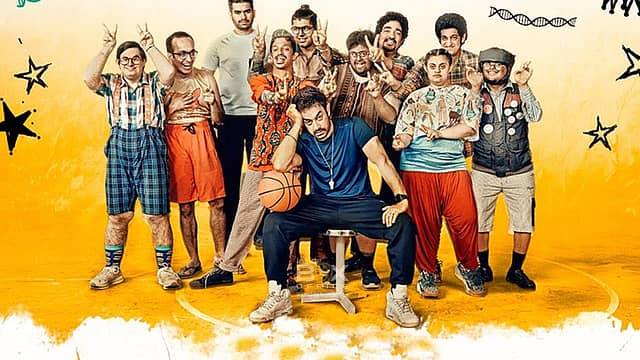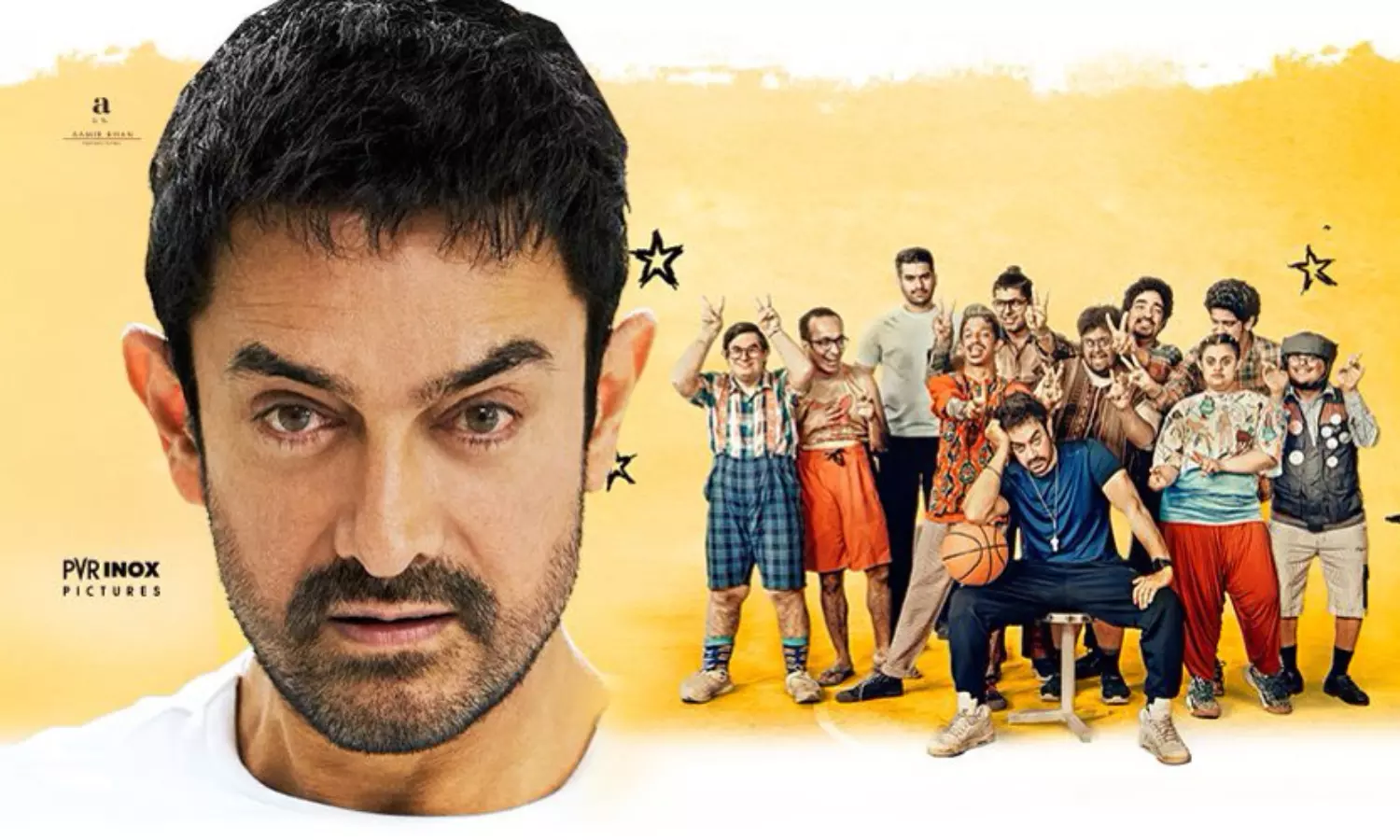A fair note of warning before you read ahead: this Sitaare Zameen Par review is not just a generic listing of the “goods” and the “bads” of the film. This newest, big-budget theatrical release has become a question larger than its craft, and certainly larger than the purportedly large moral questions that it seems to grapple with. So first, for those who are skimming, let’s get all the usual stuff one would expect out of a Sitaare Zameen Par review out of the way.
Sitaare Zameen Par, released in June 2025, is the story of a disgraced basketball coach tasked with training a team of neurodivergent players with an array of “intellectual disabilities” or IDs, as part of a court reprimand for getting caught driving drunk on the streets of Delhi. Donning the caps of both lead actor and producer, the crowd favorite Aamir Khan plays Gulshan, the burlesque coach nursing a sustained insecurity about his short stature, considered an outlier in the game of basketball.
Suspended on account of bad behaviour, Gulshan is demoted from the position of an assistant coach to a national-level basketball team to that of a charity instructor for novice basketball students at a school for those on the spectrum, individuals that are collectively described in the film as having a “mental age of 7 to 8 years.” The team includes characters with Down Syndrome, invisible autism, and Fragile X Syndrome, among others.
A star-crossed review: Sitaare Zameen Par
As one might guess, the plot is decidedly linear, and traces the rather flat redemption arc as the neurotypical, ill-tempered coach softens in his intolerant ways— a lesson that is hard-learned at the hands of his neurodivergent wards. Because this is also a sports drama, add in the mandatory training montage, an emotional but entirely predictable climax, and an underdog team that makes it against all odds, and what we have is the classic trope of the male chauvinist that must be redeemed as the ultimate savior in the end, only repackaged under Bollywood’s shiny new banner of “inclusivity.”
But even the seeming freshness of this idea only takes the film so far. The acting, even by seasoned industry experts, falls flat on its face, even as the dialogues and comic punches land a little too softly for their build-up, which seems to suggest that the problem is directorial. Shots linger too long, and tropes remain underexplored. The classic adage of the filmmakers of ‘Show, don’t tell!’ seems to be lost on R.S. Prasanna and his team, as the film inclines severely to a tone that increasingly preaches to its audience, without the backbone of a well-crafted story.
Several of the audience’s reactions were incongruent with what the film’s messaging claimed to be. Around the hall, different groups, families, and friends alike burst into misplaced peals of random laughter, more often aimed at the neurodivergent characters rather than with them
Several of the audience’s reactions were incongruent with what the film’s messaging claimed to be. Around the hall, different groups, families, and friends alike burst into misplaced peals of random laughter, more often aimed at the neurodivergent characters rather than with them. The biggest reactions were garnered only when coach Aamir Khan repeatedly used the word “pagal,” or when one of the team members broke into an exaggerated tic. The audience roared at scenes that played neurodivergence for slapstick, which made the lack of emotional resonance glaring. For a film that claimed to be about empathy and inclusion, Sitaare Zameen Par failed to live up to its intended message. What do we do with a film that ends up as a mockery of exactly what it preaches against? Is this merely an ill-received product of a less-than-progressive audience, or is there something about the very craft of the film that elicits such a hollow response?
The burdens of a sequel
It feels almost audacious on the part of the film to link Sitaare Zameen Par with its 2007 predecessor Taare Zameen Par. Marketed as a sequel in order to ride the quick rise of Bollywood’s nostalgia wave, audiences are divided on whether we can consider this to be a mere move of naive ambition or one of deep self-sabotage. It is difficult to live up to the legacy of a film that acquires cult status. While Taare Zameen Par was far from what we can call a blockbuster hit, its lack of boastful numbers at the box office is a fact that has been quickly overshadowed by its slow but consistent seepage into the cultural landscape of Bollywood. Almost a decade later, Taare Zameen Par continues to be watched and rewatched, in living rooms and classrooms alike, and for good reason.

Unlike its alleged sequel, Taare Zameen Par forges an emotional resonance lasting well past the boundaries of the cinema hall. Instead of choosing the overdone, and frankly lazy, route of laying its politics bare through an entirely predictable set of monologues, Taare Zameen Par does not take its viewers for granted, and counts on their intellectual and emotional capabilities to be able to understand the message of the film for themselves. Taare Zameen Par frames its protagonist as a ten-year-old boy with undiagnosed dyslexia, but only through his quiet quirks and endearments. He finds himself catching fish instead of finishing his homework, and lacks the ability to perceive depth and force to accurately pass a ball, all things his peers are already experts at. This causes him to be bullied by his classmates and berated by his teachers, with his parents equally frustrated with him at home.
In a recognizable instance of the Indian version of Discipline and Punish, the father assumes that only a boarding school will be able to beat Ishaan into shape. It is only toward this second half of the film that Aamir Khan, the big star power of the film, makes an appearance. He plays a substitute art teacher who not only identifies Ishaan’s gift for the fine arts but also correctly diagnoses his learning disability. The rest of the film is then a focus on the use of alternative teaching methods designed to encourage Ishaan’s exemplary artistic abilities while simultaneously redirecting them to help his Math, English, and even sports.
The film reinforces this message of differently abled, rather than disabled, understanding of learning “disorders” by contrasting Ishaan’s only friend in boarding school, Rajan. He is academically gifted, but restricted to crutches, and unable to do certain things independently. Because his disability is visible, he is received with care and compassion rather than the strict scolding that Ishaan is regularly exposed to. The nuanced undertaking of this complex commentary is pushed by the storyline and the characterizations in the film, and does not depend upon dramatic arcs or elaborate speeches to do the job for it. Sitaare Zameen Par, on the other hand, borrows the name but none of the subtlety. It wants the same emotional capital without doing the narrative work. In its attempt to recreate resonance, it ends up feeling hollow, as if the makers are more invested in appearing inclusive than telling a story that is.
From “show, don’t tell” to “preach, don’t think”
But perhaps the intention was never to tell a meaningful story in the first place. The decision to position Sitaare Zameen Par as a sequel to Taare feels less like an artistic continuation and more like a calculated marketing move. In Bollywood’s current sequel economy, films are no longer remembered for their storytelling but for their symbolic and nostalgic capital. Earlier films are repurposed to lend credibility to new ones, regardless of whether the continuity is narrative, thematic, or emotional in nature. Sitaare Zameen Par fails to extend the concerns of Taare Zameen Par. It merely exploits its predecessor as a brand, and packages social inclusion as an aesthetic, moral urgency as market currency.
Aamir Khan Productions has been touted as the flagbearer of socially conscious cinema. While this label is not unjustified, some of its recent choices ring of a lackluster circling of its values rather than a genuine passion to address a social issue. Its seepage into internet-driven woke culture further dilutes its impact, reducing complex questions of inclusion into catchphrases and clichés.
This logic is neither limited to Sitaare Zameen Par nor the general ambit of sequels alone. What we are witnessing with Bollywood is the increased tendency to prioritize brand value over storytelling prowess. More often than not, newer films are reverse-engineered to fit a production house’s existing identity. Aamir Khan Productions, for example, has been touted as the flagbearer of socially conscious cinema. While this label is not unjustified, some of its recent choices ring of a lackluster circling of its values rather than a genuine passion to address a social issue. After all, there is a difference between a film with a social cause and a film about a social cause. Unfortunately, for us and them, Sitaare Zameen Par chooses the latter. It tells us what it stands for, but never bothers to show us why. Its seepage into internet-driven woke culture further dilutes its impact, reducing complex questions of inclusion into catchphrases and clichés.

This preachiness is also why the film fails as a script. In place of layered character arcs, it gives us clumsy moral lectures dressed up as monologues. Think of Chak De’s ‘Sattar Minute’ or Aamir Khan’s own ‘Thappa Kaha Hai?’ from PK. These are powerful moments because they stay true to the story and the character. Sitaare Zameen Par tries to replicate this effect with Kartar “Paaji,” the genial Sikh character who appears too early in the film to bear the emotional gravitas he’s tasked with delivering. His well-meaning sermon, from which the film borrows its tagline ‘Sabka apna apna normal hai,’ feels unearned. Worse, it sets the tone for a story that centers not the neurodivergent team, but the redemption arc of a chauvinist coach, whose journey from ableist to ally is predictable, flat, and frankly tiring.
Why films don’t want to change you anymore
What Sitaare Zameen Par becomes, then, is a symptom of a larger problem: the commodification of storytelling in an era where marketability trumps craftsmanship. This is not just about remakes or sequels. It is about the collapsing distinction between artistic merit and moral performance. If a film aligns itself with a good cause, is that enough to be called a good film? Does intent override execution?
Cinema has always reflected the world in which it was born. In the 1990s, for example, the “larger than” quality in Bollywood came from scale: Swiss landscapes, NRIs, chiffon sarees. But the Nineties were also an era of economic and political reformation. The ruling government formulated policies that aligned with a notion of liberalization, privatization, and globalization, which was one of India’s first big steps toward a capitalist economy. This was a significant shift from the Nehruvian days of socialism. But today, we are witnessing a different “larger than,” one premised on moral superiority, where even supposedly progressive films must submit to the ruling powers to ensure box office success.
Sitaare Zameen Par markets itself as a liberal film on one hand, but also succumbs to opening with a mandatory message from Modi, the face of right-wing politics in India, on the other. In today’s industry, then, morality is not drawn from the story, but from its ability to be palatable to the largest audience possible. The shift in modes of cinema reflects a larger shift in the political Overton window. We live in a climate where storytelling has become secondary to narratives themselves. What matters more is whether a film can be branded, clipped, quoted, and circulated.
In this climate, the word “industry” no longer follows “Bollywood,” but rather replaces it. What we once called masala has now been flattened into moral marketing. Films no longer challenge belief systems, but only work to reinforce them. Gone is the subversive potential of cinema. Gone is the promise that you might walk out of a theatre changed. In its place is a product to be consumed, packaged neatly with a moral hashtag and a celebrity-endorsed quote. Once, films made arguments well ahead of their time. Today, all we find are products shelved on a soapbox.
About the author(s)
Ananya is a writer and researcher of all things literature. With a particular emphasis on film, gender, and sexuality, she is great at curating the perfect movie night, but when it comes to life itself, she's still figuring out the script.






Great write up! Well done
Excellent work!
Good insight,You may checkout my posts too , related to indian cinema ,or film review.